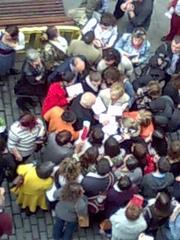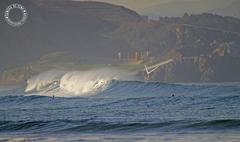
Avilés Railway Station: Visiting Hours, Tickets, and Travel Guide
Date: 04/07/2025
Introduction
Avilés Railway Station, located in the heart of Asturias on Spain’s northern coast, stands as a vital hub connecting the historic city of Avilés with the wider region and beyond. Established in the late 19th century, the station embodies the city’s evolution from a medieval port to a dynamic industrial and cultural center (Britannica; Alegria Real Estate). This comprehensive guide will equip you with practical information on visiting hours, ticketing, accessibility, history, and key attractions nearby, ensuring a seamless and enriching visit to both the station and the city.
Table of Contents
- Historical Context and Urban Integration
- Architectural Features and Station Style
- Visiting Hours and Ticket Information
- Accessibility and Facilities
- Nearby Historical Sites and Attractions
- Special Events and Guided Tours
- Visitor Tips and Best Times to Visit
- Local Transport Connections
- Sustainability and Environmental Initiatives
- Frequently Asked Questions (FAQ)
- Conclusion
- References
Historical Context and Urban Integration
Avilés Railway Station is strategically positioned north of the historic Sabugo neighborhood and a short walk from the city center, serving as a primary gateway between Avilés and the Asturias region (Alegria Real Estate). Its opening in the late 19th century coincided with the city’s industrial boom, facilitating the movement of people and goods essential for Avilés’ transformation from a medieval town to an industrial powerhouse (Britannica).
The station’s location, near the estuary and major avenues, reflects the city’s emphasis on connectivity for commerce and daily life. By bridging medieval quarters and new industrial zones, the station symbolizes Avilés’ dynamic blend of heritage and progress (Fascinating Spain).
Architectural Features and Station Style
Avilés Railway Station features functionalist and utilitarian architecture typical of 20th-century Spanish railways. The main building is a low-rise structure built with concrete, steel, and glass, emphasizing practicality over ornamentation (Mapcarta). Wide canopies shelter platforms, and large windows provide natural light. The design prioritizes efficiency, with accessible passenger routes, open waiting areas, and clear signage.
This architectural style mirrors the city’s industrial character, where factories and modern structures coexist with historic medieval and baroque buildings, creating a unique urban landscape (Alegria Real Estate).
Visiting Hours and Ticket Information
- Station Hours: Daily, 5:30 AM to 11:45 PM.
- Ticket Offices: Typically staffed from 6:00 AM to 10:00 PM.
- Train Services: Frequent regional trains to Oviedo, Gijón, and a daily Alvia service to Madrid (Renfe Official; Wikipedia).
- Ticket Purchase: Tickets are available at station counters, automated machines, and online via Renfe’s website or apps like Omio (Omio).
- Fares: Regional Cercanías tickets start from approximately €2. Long-distance fares vary by destination, class, and purchase date.
- Discounts: Available for seniors, youth, and families, along with promotional fares during certain periods.
Advance booking is recommended during peak travel seasons and local festivals.
Accessibility and Facilities
Avilés Railway Station is designed with inclusivity in mind:
- Accessibility: Ramps, elevators, tactile paving, and step-free access throughout.
- Facilities: Waiting areas, restrooms, vending machines, and real-time information screens.
- Assistance: Trained staff provide support to travelers with special needs.
- Luggage: No dedicated left-luggage facility; city center options are available.
- Parking: Free paved lots nearby; pedestrian routes link to the city center.
Nearby Historical Sites and Attractions
The station’s central location makes it easy to explore Avilés on foot:
- Sabugo Neighborhood: Picturesque streets, Romanesque-Gothic Old Church of Sabugo, and the Church of St. Thomas of Canterbury (Alegria Real Estate).
- Plaza de España: The lively central square, hosting markets and cultural events (Explorial).
- Oscar Niemeyer International Cultural Centre: A modern architectural icon with exhibitions and performances (Journey Gourmet).
- Ferrera Park: A green oasis for relaxation.
- Museum of Avilés Urban History: Insight into the city’s past and industrial heritage.
Special Events and Guided Tours
During major festivals such as the Bollu Festival and the Summer Carnival, the station becomes a focal arrival point for visitors (Audiala). While the station itself does not offer guided tours, local tourism offices organize walking tours highlighting Avilés’ architectural and cultural heritage, often starting at or near the station (Avilés Tourism).
Visitor Tips and Best Times to Visit
- Best Times: Early mornings and late afternoons are less crowded.
- Peak Hours: Weekday rush hours (7–9 AM, 5–7 PM).
- Weather: Asturias’ oceanic climate brings frequent rain—pack accordingly (Avilés Climate).
- Language: Spanish is predominant; some English is spoken in tourist areas.
- Connectivity: Free Wi-Fi is not guaranteed; consider a local SIM card.
Local Transport Connections
- City Buses: Stops adjacent to the station connect to neighborhoods and towns.
- Taxis: Taxi rank at the entrance; metered rides to city destinations and Asturias Airport.
- Walking: Most attractions are within a 10–15 minute walk.
- Car Rentals: Available near the station and airport for regional exploration (Opreismetco).
Sustainability and Environmental Initiatives
Avilés Railway Station promotes sustainable travel by encouraging the use of public transit and rail, reducing traffic congestion and emissions. Urban improvements have expanded pedestrian zones and green spaces, contributing to environmentally friendly tourism and mobility (Asturias.com).
Frequently Asked Questions (FAQ)
Q: What are the Avilés Railway Station visiting hours?
A: The station operates daily from 5:30 AM to 11:45 PM; ticket offices are staffed 6:00 AM–10:00 PM.
Q: Where can I buy tickets?
A: At the ticket office, automated machines, or online via Renfe’s website and apps like Omio.
Q: Is the station accessible for travelers with disabilities?
A: Yes; ramps, elevators, tactile guidance, and assistance are available.
Q: Are there luggage storage facilities?
A: No dedicated facility at the station; check city center options.
Q: What are the main historical sites nearby?
A: The Sabugo neighborhood, Plaza de España, Oscar Niemeyer International Cultural Centre, and Ferrera Park.
Q: Are guided tours available?
A: Local tourism offices organize walking tours—check for current offerings.
Conclusion
Avilés Railway Station is more than a transit hub; it is a testament to the city’s industrial legacy and a springboard for exploring Avilés’ cultural riches. Its strategic location, accessibility, and facilities make it the ideal starting point for visitors eager to discover Asturian heritage and contemporary life. For a smooth and enjoyable experience, plan ahead using official resources and apps, and immerse yourself in the vibrant blend of history and modernity that Avilés offers.
References
- This article draws on information from several authoritative sources, including:
For real-time updates, download the Audiala app or visit official resources for travel planning and tips.














